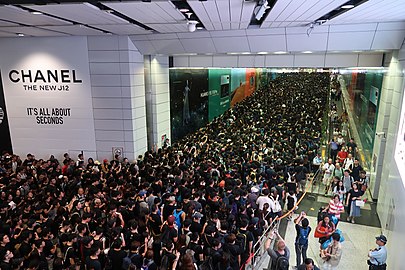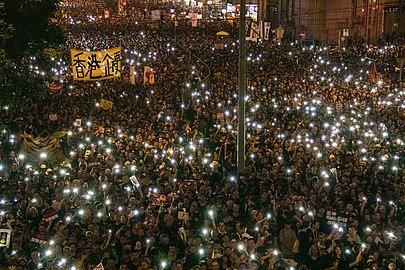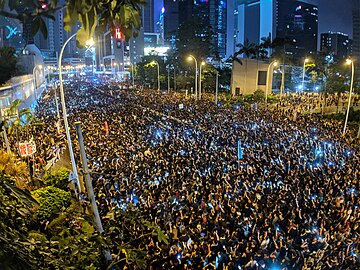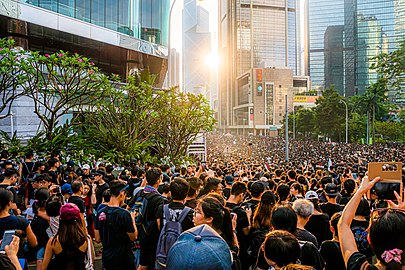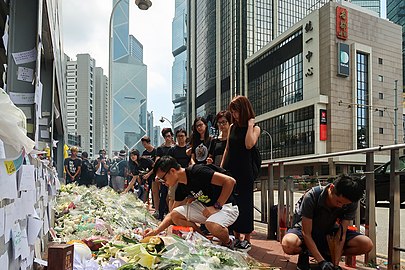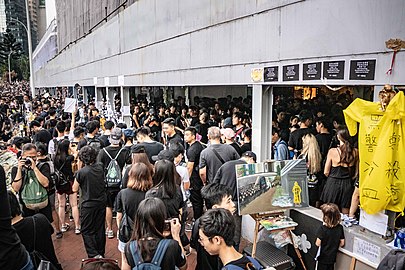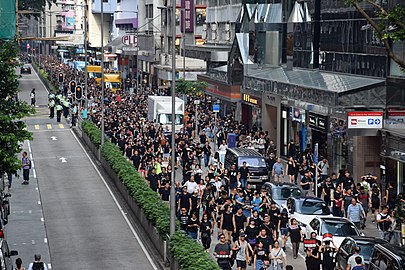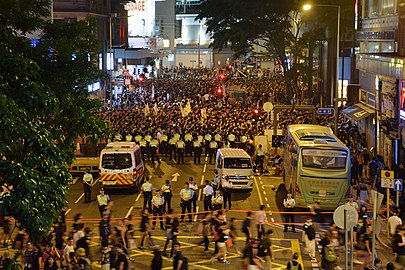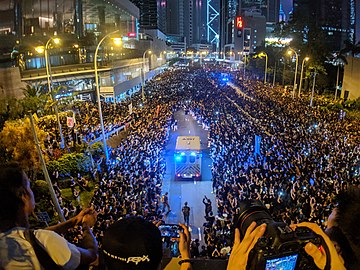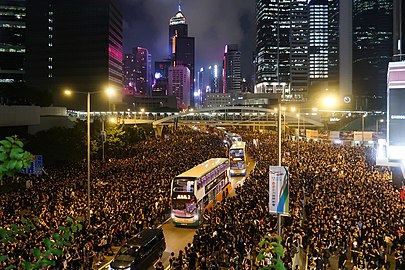User:Vampyricon/16 June 2019 Hong Kong protest
| This is not a Wikipedia article: It is an individual user's work-in-progress page, and may be incomplete and/or unreliable. For guidance on developing this draft, see Wikipedia:So you made a userspace draft. Find sources: Google (books · news · scholar · free images · WP refs) · FENS · JSTOR · TWL |
16 June 2019 Hong Kong protest march User:Vampyricon/16 June 2019 Hong Kong protest/UTC+8
| 16 June Hong Kong Protest March | |||
|---|---|---|---|
| 「譴責鎮壓,撤回惡法」大遊行 Part of 2019–20 Hong Kong protests | |||
 Protesters passing through Hennessy Road in Wan Chai at 7 p.m. | |||
| Date |
| ||
| Location |
| ||
| Caused by |
| ||
| Goals | Five Demands
| ||
| Methods | Mass demonstrations and protest marches | ||
| Resulted in |
| ||
| Parties | |||
| |||
| Number | |||
| |||
| Casualties | |||
| Injuries | 33 hospitalized, 1 under life-threatening condition | ||
| 2019–2020 Hong Kong protests |
|---|
.svg/120px-Emblem_of_Hong_Kong_(Black_Bauhinia_with_wilted_petals_variant).svg.png) |
The 16 June 2019 Hong Kong protest (Chinese: 「譴責鎮壓,撤回惡法」大遊行; lit. 'Denounce crackdowns', 'repeal evil law" march')[10] was held by the Civil Human Rights Front (CHRF) on 16 June 2019 in the same vein as an earlier protest on 9 June. Due to the postponement[b] of the extradition bill amendment bill on 15 June, the main thrust of public criticism had pivoted from the bill itself to the abuse of authority by the police during the protest on 12 June. Five demands were proposed in the protest: A full withdrawal of the extradition bill, the release and exoneration of arrested protesters, an inquiry into the excesses of the police such as the use of tear gas and rubber bullets and the prosecution of protesters using medical information from hospitals, the retraction of the characterization of the 12 June 2019 protests as "riots", and the resignation of the Chief Executive Carrie Lam. The government did not respond to these requests, which caused significant delays to the resolution of the protest movement.[11][12]
The protest received international coverage, reaching the headlines of the American print editions of the New York Times and the Washington Post.[13][14] Estimates of the number of protesters have often differed severalfold between protest organizers and the Hong Kong Police Force (HKPF),[15] and the number of participants in this protest became a focus of international media. The organizers of this protest estimated 2 million and 1 protesters, beating out the 28 May 1989 protest of 1.5 million in support of Beijing students protesting for the democratization of China as the greatest protest in the history of Hong Kong. However, the HKPF estimated only 338 thousand took part in the demonstration at its peak.[c] However, the method used by the HKPF to count the number of protesters has led to skepticism of their estimate by news media such as Reuters,[4] the BBC,[17] CommonWealth Magazine,[18] and the Hong Kong Free Press.[19] The speed at which this protest was organized, and the fact that there were enough protesters that the protest spilled over onto adjacent roads, caused even more difficulties in counting their numbers. Of the many third-party estimates, Reuters and Japanese media only cited social scientist Paul Yip's estimate of "500-800 thousand people".[4][20][21]
Background[edit]
In 2019, the Hong Kong government proposed an amendment to the extradition law which would allow, on a "case-by-case basis", the Chief Executive of Hong Kong to extradite fugitives to any territory with which Hong Kong does not have an extradition treaty, such as "other parts of China outside Hong Kong". This amendment bill was proposed in response to the murder of Poon Hiu-wing in Taiwan, and is stated to plug a "serious legal loophole". While it is claimed that this amendment bill would "retain and apply all human rights safeguards" of the original extradition bill, concerns have been raised as soon as it was proposed as to whether such an amendment would weaken the independence of Hong Kong's judiciary.[22][23] As of January 2022, fugitives still cannot be transferred to Taiwan under Hong Kong law.
On 20 May, the government demanded that the extradition bill amendment bill be examined directly during the Legislative Council meeting of 12 June, bypassing the Bills Committee. This led to a protest on 9 June organized by the CHRF in protest of the forcible submission of the bill. The organizers claimed 1.03 million citizens participated in the demonstration, while the HKPF claimed 240 thousand at its peak. That night, the government once again stated its intention to submit the bill directly for examination.
In order to prevent the second reading of the bill by the Legislative Council, many Hongkongers went on strike and instead held a protest in Admiralty. Afterwards, they occupied the roads near the Legislative Council in order to prevent the meeting from being held. The police used rubber bullets and bean bag rounds, among other weapons, against protesters, leading to more than 80 casualties. The Hong Kong Police Force categorized this protest as a "riot", causing anger among the populace. As such, on 13 June, the Civil Human Rights Front applied for a demonstration on 16 June with the police.[24]
Organization[edit]
Second demonstration by the CHRF[edit]
In the afternoon of 15 June, Chief Executive Carrie Lam held a press conference announcing the postponement[b] of work on the extradition bill amendment bill, and communicate with the public. She stated that the government would decide on the next step after it takes into account differing opinions and reports to the Legislative Council's Panel on Security, such that legislators' opinions can be taken into account. She has further stated that there was no intention to set a deadline for such work.[25]
The CHRF responded by pointing out that a postponement was not a withdrawal, and thus the protest will take place as planned.[26]
Death of Marco Leung Ling-kit[edit]
Around 4:00 p.m. on 15 June, the 35-year-old Marco Leung was sitting dangerously on a platform on Queensway's Pacific Place. He was wearing a yellow raincoat on whose back "Lam Cheng kills Hong Kong; Dirty Cops are Cold-Blooded"[d] (Chinese: 林鄭殺港 黑警冷血」) was written.[27] He had also hung up banners which said "No Extradition To China" in both Chinese and English (Chinese: 「反送中 No Extradition To China」; lit. 'No Extradition To China No Extradition To China"') as well as "Fully withdraw extradition to China; we are not rioters; release injured students; Lam Cheng, step down; Help Hong Kong" (Chinese: 「全面撤回送中,我們不是暴動,釋放學生傷者,林鄭下台,Help Hong Kong」). The police quickly blocked off two of the westward lanes of Queensway to handle the incident. The police only allowed their Negotiation Cadre to negotiate with Leung, and stopped legislator Roy Kwong Chun-yu from approaching.
At around 9:00 p.m., Leung suddenly climbed off the scaffolding. Many firefighters attempted to pull him back onto the platform, but failed. Although there was an inflated jump rescue cushion on the ground, it could not be placed next to the building due to the scaffolding and the fences between the sidewalk and the road. As such, Leung landed on the sidewalk between the building and the cushion, and fell unconscious with heavy injuries. He was sent to Ruttonjee Hospital, but died of his injuries.[28][29] He left two wills, addressing his posthumous affairs and expressing his opposiiton to the extradition bill respectively. Afterwards, Hongkongers, inlcuding Chu Yiu-ming, one of the founders of the Occupy Central movement, offered flowers outside Pacific Place in Leung's memory.
After the incident, pro-Beijing web media Dot Dot News quoted online rumors which claim Leung was connected with several crimes and only acted due to having received money from Kwong. They further claimed that Leung's final call was with Kwong, discussing the problem of monetary transfers, as well as Kwong left without acknowledging Leung's fall.[30] Kwong called such rumormongers dispicable, and described Dot Dot News as "making news by trampling on the dead"[e], disgraceful, and violating basic ethical principles. Kwong also claimed that their report throws in wild accusations, and has stated that he would seek legal action against the libelous report.[31][32]
Timeline[edit]
16 June[edit]




Much like the protest on 9 June, this protest started in the Central Lawn of Victoria Park in Causeway Bay and ended at the Legislative Council Complex in Tim Mei Avenue of Admiralty, but the police also opened up the six football pitches due to the turnout. The organizers recommended that participants wear black clothing. At around noon, participants slowly gathered at Victoria Park.[33] However, at around 2 p.m. when the protest march was about to begin, waves of protesters surged towards Hong Kong Island. Major transit stations of the MTR were filled with protesters in black clothing, forcing them to enact crowd management measures, including stopping escalators, sending staff to guide passengers, halting entry into stations, and sending out more trains.[34] The platforms in Tin Hau Station, which is near Victoria Park, became too crowded starting at 2:00 p.m., and certain trains skipped the station. This measure was cancelled one hour later.[35][36] Some train operators used the announcement system to express support for the protest.[37]
Regarding other transportation, KMB announced that morning that they would allocate more buses to cross-harbor routes, including routes number 102, 106, 112, and 116, as well as routes connecting the New Territories to Hong Kong Island.[38] Starting from the afternoon, large numbers of protesters arrived at the Cross-Harbour Tunnel's bus transfer hub for busses to Hong Kong Island, causing the queue to extend into the Hung Hom MTR station.[39] At the same time, quite a few citizens decided to Victoria Harbour using the Star Ferry, leading to large crowds around the Tsim Sha Tsui Ferry Pier. The end of the line reached the Avenue of Stars, near the InterContinental Hong Kong. Due to the crowds, several Star Ferry employees and police officers were on site to maintain order, and more employees were sent to the back of the line to organize the queue.[38] Not long afterwards, the line extended over a kilometer.[40]
Due to the number of protesters, the CHRF decided to start the march at 2:43 p.m., earlier than the planned start time of 3:00 p.m. Banners with the words "wikt:痛心疾首" and "Withdraw the bill" Chinese: 「撤回惡法」; lit. 'Repeal evil law"' were held at the front of the march. Other protesters had already started marching on Causeway Road prior to the official starting time, causing the stretch of road outside Victoria Park to be blocked off earlier, in contrast with the arrangements on 9 June.[41] The police force was also more lenient regarding the arrangements of the protest, and did not stop citizens joining in from Yee Wo Street or Lee Garden Road in Causeway Bay, or Hennessy Road in Wan Chai, and further opened up a stretch of King's Road's tram rails so protesters could directly join the protest from the Fortress Hill MTR station. The tail end of the protest has stretched to North Point.[42][43]
| Crowds at the protest |
|
Some protesters diverted to Pacific Place to memorialize Marco Leung Ling-kit, who had fallen off the building and died the day before. By the time the protest march started, the line of those paying their respects had extended to the Garden Road stop of the Peak Tram of the Mid-Levels.[44][45]
During the march, the "Anti-Extradition Protest Fund", founded by celebrity Denise Ho, university professor Hui Po-keung, and former Legislative Councillors Margaret Ng and Cyd Ho, set up a booth to raise funds for those who were injured or arrested during the extradition bill protests. At the same time, many democratic organizations and political parties also set up booths along the route of the march to raise funds for the fund above.[46] The Bishop Emeritus of Hong Kong, Joseph Zen, was also seen at the booths outside Southorn Playground in support of the protest.
| Paying respects |
|
At 4:00 p.m., the first protesters reached Tim Mei Avenue in Admiralty, and it was announced that Lockhart Road was opened to divert the crowds.[47][48] However, the CHRF representatives holding the banners at the front of the march were unable to proceed past the Causeway Bay Sogo. Only after almost 50 minutes was a path opened up, and the bannermen proceeded along the eastward lanes of Hennessy Road, and were cheered on by protesters.[49] At 4:30 p.m., some protesters were shunted to one of the westward lanes on Gloucester Road, the outermost main road on Hong Kong Island, and Jaffe Road. At the time, due to the many protesters joining in the middle of the route, many protesters gathered at Tin Hau and Fortress Hill were unable to begin, and were waiting on King's Road to join in.[49] At 5 p.m., all lanes on Lockhart Road were opened to protesters to divert the crowds on Hennessy Road.[50]
The Legislative Council protest area, which was closed on 12 June, was opened for this protest. The gate to the parking lot of the protest area were not closed, nor were there barriers inside, allowing citizens to enter and exit freely. Several dozen police officers were posted at the public entrance, but did not patrol within the protest area. Afterwards, as citizens reached the end of the march, they arrived at the LegCo protest area and Tamar Park, and spread out in the direction of CITIC Tower. Due to the number of people, the organizers advised those who have reached the end to gather in the direction of Tim Wa Avenue.[51]
-
Due to the number of protesters, some participants decided to join the protest on King's Road.
-
Due to the crowds, some protesters were diverted via Lockhart Road.
-
Protesters overflowed into Hennessy Road and Lockhart Road; police prepared on Fenwick Street.
At 5 p.m., the Civil Human Rights Front stated that citizens do not need to call for opening up more roads, since all roads that could be opened up on Hong Kong Island had been opened to protesters already. At 5:30 p.m., Tin Lok Lane, Wan Chai Road, Johnston Road, and one of the westward lanes of Gloucester Road were also opened to divert protesters.[49][52]



Around 6 p.m., all protesters have left Victoria Park. The police thus closed Causeway Road to protesters. Late arrivals had to join the march at Sugar Street.[53] At the same time, due to the many protesters, some continued on Harcourt Road outside Admiralty Centre, and some even crossed over the concrete dividers between the eastward and westward lanes. Many protesters followed, occupying all lanes of Harcourt Road. Many buses and cars were trapped in the crowds, but as the buses slowly moved forward to leave the scene, the crowds parted to allow their departure.[54][55]
Many citizens continued joining the protest even after dark, making the end of the march hard to identify.[53] The end of the march had just reached Southorn Playground in Wan Chai at around 9 p.m. The police cleared the roads after the last protesters, advising that those behind continue the protest on the sidewalks.[56] Around 11 p.m., the police pushed the end of the procession up to Queensway opposite the police headquarters in Wan Chai, then stopped proceeding.[49] Officers responsible for re-opening Hennessy Road, after doing so, returned to the police headquarters. Only a few police officers were left to guard the boundary between Hennessy Road and Queensway at that time.[57]
Many citizens were still gathered near Pacific Place on Queensway at around 11 p.m. to pay respects to Marco Leung Ling-kit, who had fallen to his death there the day before.[57] Even after midnight, many citizens were gathered on another main road, Harcourt Road, as well as the nearby Lung Wo Road, Tim Wa Avenue, and Tim Mei Avenue, effectively occupying those roads. The gathered people generally did not accept Chief Executive Carrie Lam's written apology, and there are occasionally shouts of "Lam Cheng, step down!"Cite error: Admiralty station to the government headquarters, on which were written "We are not rioters" (Chinese: 「我們不是暴徒」), "Withdraw the amendment bill" (Chinese: 「撤回修例」), and "No extradition to China" (Chinese: 「反送中」).[59] At the time, a group of pan-democrat legislators showed up to remind protesters to remain "not bleeded, not hurt, not arrested" (Chinese: 「不流血、不受傷、不被捕」). Legislator Roy Kwong stated that he could not stand another protester getting hurt, and that he wished the citizens remaining took care of each other. On the other hand, legislator Wu Chi-wai stated that the successful occupation of the main roads of Admiralty has applied sufficient pressure to Carrie Lam, and asked them to be careful.[60]
| Protesters parting to allow vehicles through This has been called Hong Kong's version of Moses parting the Red Sea, and was praised as exhibiting Hongkongers' orderly behavior during protests. |
|
17 & 18 June[edit]
Although most protesters have left by around 2 a.m. on 17 June, the government headquarters, Harcourt Road, Lung Wo Road, and the streets surrounding the Legislative Council are still occupied by protesters. There were around 100 people on Harcourt Road, and many police vehicles were guarding the Office of the Chief Executive. At 7 a.m., the Senior Superintendent of Police (Community Relations) of the Police Public Relations Branch, Yu Hoi Kwan, suggested that protesters on Harcourt Road and Lung Wo Road return to the sidewalk, and emphasized that it was not an attempt to clear the scene. Around 150 police officers and negotiators attempted to persuade protesters to leave, but returned after 1 hour, unsuccessful. The police temporarily retreated at 8 a.m.[61] However, as there were no protesters making a stand on Lung Wo Road, police officers left after removing the protesters' perimeter, and reopened the road at 8:30 a.m. The government announced that the government headquarters will remain closed.[62]
At 10 a.m., protesters originally sitting on Harcourt Road and the embankments on both sides cleaned up the garbage on the ground, then moved to Tamar Park, the sidewalk on Tim Mei Avenue, and the designated protest area of LegCo, allowing traffic to flow through Harcourt Road once more. Protesters participating in negotiations stated that they did so as a gesture of goodwill towards the government, and wished to gain the approval of citizens. Au Nok-hin, who arrived to coordinate, stated that occupying the road would lead to adverse consequences, and advised protesters to save their strength. At 10:53 a.m., Harcourt Road was once again open to traffic.[63]
In the afternoon, around 400 citizens gathered at the designated protest area of the Legislative Council. At the time, some of the gathered protesters suggested a march to the Chief Executive's residence of the Government House, or to hold another memorial for Marco Leung Ling-kit, but no consensus was reached. At 4 p.m., Eddie Chu rallied citizens to gather outside the Office of the Chief Executive to reiterate some of the Five Demands, namely the withdrawal of the extradition bill amendment and to retract the characterization of the 12 June protest as a riot. Chu believed Carrie Lam should respond within a set time, instead of having them wait indefinitely. The number of protesters gathered had passed a thousand, and quite a few were standing directly on Lung Wo Road. Some others placed traffic cones to stop vehicles from passing through, in effect occupying Lung Wo Road.[64] By the evening, there were still more than 500 protesters gathered, and in the early hours of 18 June, there remained more than 100 people, but the situation was peaceful. At the time, all lanes of Lung Wo Road were still blocked by traffic cones. Police officers had not attempted to stop them since the afternoon of 17 June, hence Lung Wo Road was still closed to traffic.[65]
At 3 a.m. on 18 June, the several dozen protesters remaining moved to the protest area in LegCo due to the weather, and Lung Wo Road was free of protesters. At around 6 a.m., Lung Wo Road was reopened to traffic after police officers cleared out the traffic cones. However, the section of Tim Wa Avenue in front of the Office of the Chief Executive was still closed. Many police officers guarded the area, and many crowd control barriers were present. The government headquarters were reopened as well.[66]
-
On 17 June, protesters lying on mats in the LegCo protest area refuse to leave.
-
In the afternoon of 17 June, Eddie Chu rallies citizens to gather outside the Office of the Chief Executive; Those present were discussing whether to set a deadline for Carrie Lam to meet with them.
Number of participants[edit]
The number of participants is controversial. The numbers reported by the organizers and the police force regularly differ by severalfold, and some Hongkongers have taken to using the average as the true number.[15] Other Hongkongers ignore the data provided by the police, as their numbers report the number of protesters at the beginning and at the peak, differing from the organizers' and third-party observers' estimates of the total number of protesters. However, due to foreign media coverage of this protest, participant number estimates have come under unprecedented scrutiny. The statistical methodology and its politicization have also been the subject of in-depth reports by foreign media.[4][17][18][19] The organizers have reported that the number of protesters was "close to 2 million and 1" (the "1" represents Marco Leung Ling-kit, who fell to his death on 15 June due to his anti-extradition bill protest), breaking the 1.5 million record of the Worldwide Chinese Protest March in support of the 1989 student protests to become the protest with the greatest number of participants reported by the organizers. However, the police reported a peak number of 338 thousand.[c] The vast gulf between the statistics led to skepticism by a wide variety of media including Reuters,[4] the BBC,[17] and CommonWealth Magazine.[18][19] The speed at which this protest was organized, and the fact that there were enough protesters that the protest spilled over onto adjacent roads, caused even more difficulties in counting protester numbers. Of the many third-party estimates, Reuters and Japanese media only cited social scientist Paul Yip Siu Fai's estimate of "500-800 thousand people".[20][21]
Other estimates that went uncited by foreign media include building surveyor Edward Yiu's flow rate model, which yielded between 1.12 and 1.84 million protesters, and economist Francis Lui's area-based model, which yielded 400 thousand.[7] However, when Texas State University geographer Edwin Chow Tzee Kiu[f] reviewed Lui's use of the model for the 9 June protest, it was found that the area was 148 thousand square kilometers,[67] instead of the 105 thousand square kilometers as stated by Lui.[7] ASI Analytics & Media used big data to track the trending moving average of keywords and predicted before the protest occured that the number of protesters would exceed 892 thousand with 85% probability and 1.44 million with 72% probability, and warned that public opinion is turbulent.[8][68]
On 13 September, when the CHRF appealed the rejection of their planned protest gathering and protest on 15 September by the police, the Department of Justice lawyer representing the police rejected the appeal, stating that if 2 million people joined the protest on 15 September, the police may not be able to maintain order.[69][70]
Global support[edit]
After the 16 June protest, many cities worldwide also held anti-extradition bill protests.
| North America (9) | Oceania (8) | Asia (4) | Europe (2) |
|---|---|---|---|
Responses[edit]
Government[edit]
A government spokesperson held a press release at 8:29 p.m. on 16 June, stating Chief Executive Carrie Lam apologizes for the extradition bill amendment, but didd not respond to any of the organizers' requests.[71]
| “ | [...] The Government understands that these views have been made out of love and care for Hong Kong. The Chief Executive clearly heard the views expressed in a peaceful and rational manner. [...] [...] The Government reiterated that there is no timetable for restarting the process. The Chief Executive admitted that the deficiencies in the Government's work had led to substantial controversies and disputes in society, causing disappointment and grief among the people. The Chief Executive apologised to the people of Hong Kong for this and pledged to adopt a most sincere and humble attitude to accept criticisms and make improvements in serving the public. |
” |
On 18 June, Carrie Lam made her first public appearance after the 16 June protest and personally apologized to Hongkongers, but contrary to expectations did not bow in apology or officially withdraw the amendment bill. User:Vampyricon/16 June 2019 Hong Kong protest/Cquote 3 Chinese: 我在此向每一位香港市民真誠道歉
China[edit]
On 24 September 2021, 2021年9月24日,China's Ministry of Foreign Affairs (MFA) published List of Truths About America's Interference in Hong Kong's Affairs and Support for Anti-China, Chaosifying-Hong-Kong Forces (Chinese: 《美國干預香港事務、支援反中亂港勢力事實清單》), which lists in detail the United States and other western countries' speech and actions in regards to Hong Kong's affairs. The MFA criticized Speaker of the United States House of Representatives Nancy Pelosi's statements, and further claimed that the protest of 16 June was "a public act of indulging and encouraging the use of illegal and violent methods by anti-China forces and forces destabilizing Hong Kong to oppose the central and SAR governments" (Chinese: 「公然縱容和鼓勵反中亂港分子採取違法暴力手段同中央和特區政府對抗」).[73][74] (not sure if these two cites should be merged)
USA[edit]
Speaker of the United States House of Representatives Nancy Pelosi described the protest of 2 million people "a beautiful sight to behold".
See also[edit]
- 12 June 2019 Hong Kong protest
- Hong Kong–Taiwan relations
- Hong Kong–mainland China relations(Hong Kong–Mainland China conflict)
- Hong Kong 1 July marches
Notes[edit]
- ^ Prediction made by ASI Analytics & Media by tracking the moving average of trending keywords. The death of activist Marco Leung the previous night was not accounted for in the prediction.
- ^ a b The extradition bill was described as "暫緩", which means "to postpone or defer". However, the government referred to it as a "suspension" in its English material.
- ^ a b Only protesters along the planned route were counted, while those outside were not.[16] The number of protesters was great enough that they could not be confined to the original route.
- ^ Lam is often referred to as "Lam Cheng" in Cantonese, as her full name is Carrie Lam Cheng Yuet-ngor. Her maiden name is Cheng.
- ^ Chinese: 「踩著死者屍體去作新聞」; lit. 'stepping on the corpse of the dead to make up news"'
- ^ Dr. T Edwin Chow https://faculty.txstate.edu/profile/1921922 [vat pls halp]
References[edit]
- ^ 民間人權陣線 (15 June 2019). "【今日遊行路線】兩點半,維園見". Facebook. Archived from the original on 18 June 2019. Retrieved 16 June 2019.
- ^
- ^
- ^ a b c d e
- ^ Cite error: The named reference
nyt0703was invoked but never defined (see the help page). - ^
- ^ a b c
- ^ a b
- ^
- ^
{{cite web}}:|author=has generic name (help)(in Chinese) - ^
- ^
- ^
- ^
- ^ a b
- ^
- ^ a b c
- ^ a b c
- ^ a b c
- ^ a b
- ^ a b
- ^
- ^
- ^
- ^
- ^
- ^
- ^
- ^
- ^ [permanent dead link]
- ^
- ^
- ^
- ^
- ^
- ^
- ^
- ^ a b
{{cite web}}: CS1 maint: numeric names: authors list (link) - ^
- ^
- ^
- ^
- ^
- ^
- ^
- ^
- ^
- ^
- ^ a b c d
{{cite web}}: CS1 maint: numeric names: authors list (link) - ^
- ^
- ^
- ^ a b
- ^
{{cite web}}: CS1 maint: numeric names: authors list (link) - ^
- ^
- ^ a b
- ^
- ^
- ^
- ^
- ^
- ^
- ^
- ^
- ^
- ^
- ^
- ^
- ^
- ^
- ^
- ^
{{cite news}}: CS1 maint: url-status (link) - ^
{{cite news}}: Unknown parameter|status=ignored (help)
External links[edit]
- How Big Was Sunday’s Protest In Hong Kong? These Aerial Images Show YouArchived 2019-09-12 at the Wayback Machine - 紐約時報 (in English)
User:Vampyricon/16 June 2019 Hong Kong protest/2019–2020 Hong Kong protests
Category:2019 protests Category:2019–2020 Hong Kong protests


